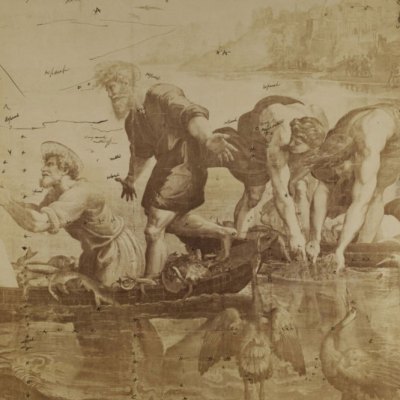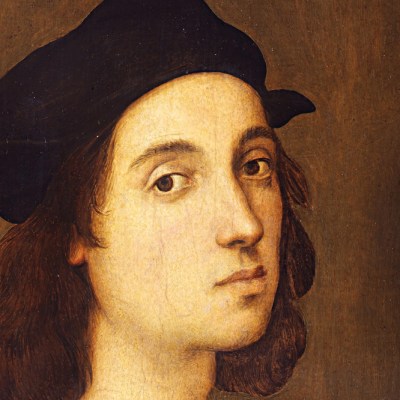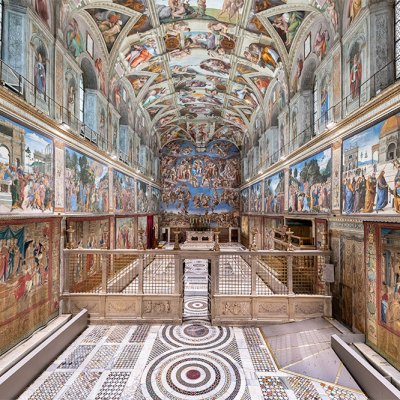Did Raphael know his fish? It’s a question that took me not to books or archives, but straight to my fishmonger. Where better to decipher the catch depicted in Raphael’s cartoon for the Miraculous Draught of Fishes?
What had piqued my interest was the new presentation of the Raphael Cartoons on the V&A’s website, where an interactive tool allows you to zoom in on high-resolution photographs of the monumental tapestry designs commissioned from Raphael in 1515. According to the site, the fisherman Simon (soon to be renamed St Peter) has caught the following types of fish: barbels, John Dory (also known, appropriately, as St Peter fish), sardines, sea bream, sea eels, shark and skate. Raphael or his assistants knew something about fish, then, but did they know what St Peter might have caught? Perhaps not: the Sea of Galilee is actually freshwater (it’s also known as Lake Tiberias or Kinneret), but the fish caught by Christ’s apostles here, barbels aside, are saltwater creatures.
Something fishy: the eponymous creatures in Raphael’s cartoon for the Miraculous Draught of Fishes. Photo: © V&A; courtesy Royal Collection Trust/HM Queen Elizabeth II 2021

London-bound during the third lockdown and missing the freshly caught sea fish of West Sussex, where I often spend time, I decided to test the identification with the experts at Something Fishy, a fishmongers in East Wittering. They confirmed John Dory, bream and shark. But they also identified cod, eel (their tails just visible in the water), the thin, long-beaked garfish, grouper, rays and whiting.
Bream (c. 1600–20), possibly by Aert Spiering. © The Trustees of the British Museum
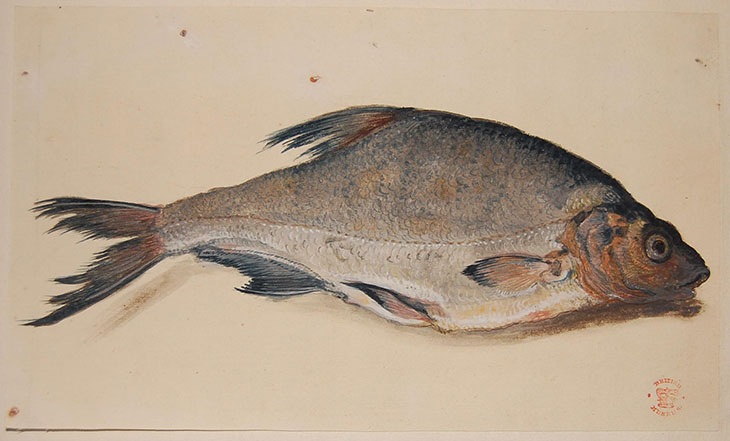
The cranes, fish and plants in the Miraculous Draught are attributed to Raphael’s assistant Giovanni da Udine, whom Vasari praised for a ‘so well varied’ rendering of ‘all kinds of birds and beasts’. Few of Giovanni’s drawings are identified, but the British Museum’s early 17th-century drawings attributed to Aert Spiering, a tapestry manufacturer in Delft, provide useful comparisons. Preserved by his brother Pieter Spiering van Silvercroon – a diplomat, art agent and collector based in The Hague, who advised Queen Christina on her collection and became envoy to the Swedish Court – the album was given to the British Museum by Sir Hans Sloane in 1753. The watercolours it contains include detailed depictions of bream and whiting that, precisely rendered in bodycolour on unpainted paper, provide a visual counterpart to the catch in Raphael’s boat.
Did Giovanni conduct research to find out what fish had been netted in ancient Roman times? Was there visual evidence in Renaissance Rome or the nearby port of Ostia for the variety of fish that had contributed to the Roman diet? Some Ostian mosaic floors record saltwater fish, including shellfish. And as my colleague Mark Evans, senior curator of paintings at the V&A, has pointed out, the Fish Mosaic at Palestrina near Rome was visible and known during the 15th century. But it may have been that the artists relied on contemporary piscine tastes. In Raphael’s Rome the main food market was in Piazza Navona. With the annual calendar of saints’ days (some 150), plus Fridays and the 40 days of fasting in Lent, fish was an essential source of protein; every Roman housewife would have been familiar with the range that was available.
Fish Market (1568), Joachim Beuckelaer. Metropolitan Museum of Art, New York
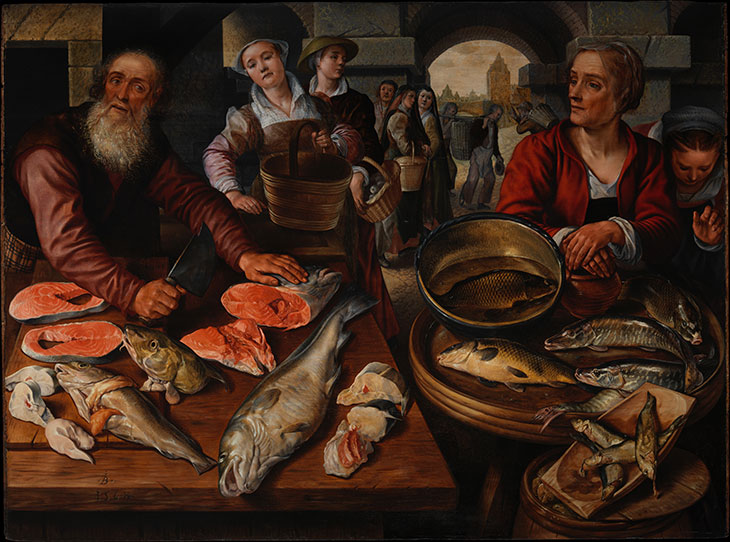
I have not found 16th-century paintings of Roman fish markets, which would have offered some indication of what was available on the fish stalls of Piazza Navona. If Giovanni had painted from what he saw in the streets of Rome, in some sense the Miraculous Draught of Fishes could be taken as a precursor to the types of market scenes that became popular later in the century, with their realistic depictions of fresh produce. The paintings of Joachim Beuckelaer, for example, capture the range of fish available in Antwerp in 1568. His market scenes were popular in northern Italy and inspired the Cremonese Vincenzo Campi and Annibale Carracci in Bologna to paint food stalls. In early 17th-century Antwerp, Frans Snyders painted the markets for fish, meat, vegetables and fruit in a set of four canvases now held in the State Hermitage Museum, St Petersburg.
If Giovanni had sought to depict freshwater fish, he might have looked to other parts of Italy, where it was certainly consumed at the time. The first original Italian cookbook, compiled by Cristoforo di Messisbugo, was published in Ferrara the year after his death in 1549. Banchetti composizioni di vivande e apparecchio generale (Banquets, Composition of Dishes and General Presentation) reflected his role at the d’Este court of Duke Alfonso and his son Cardinal Ippolito. The book opens with the wedding banquet held in 1529 for Alfonso’s eldest son Ercole and his bride, the French princess Renée, which had to compete with the hospitality of François I’s royal court. The festivities in Ferrara were held on a fast day so no meat could be served. Messisbugo’s seven-hour banquet included a variety of freshwater fish from the nearby Po River, including crayfish and lampreys – likelier catches for the Sea of Galilee.
Mosaic (50 BC–50 AD), excavated in Rome. © The Trustees of the British Museum
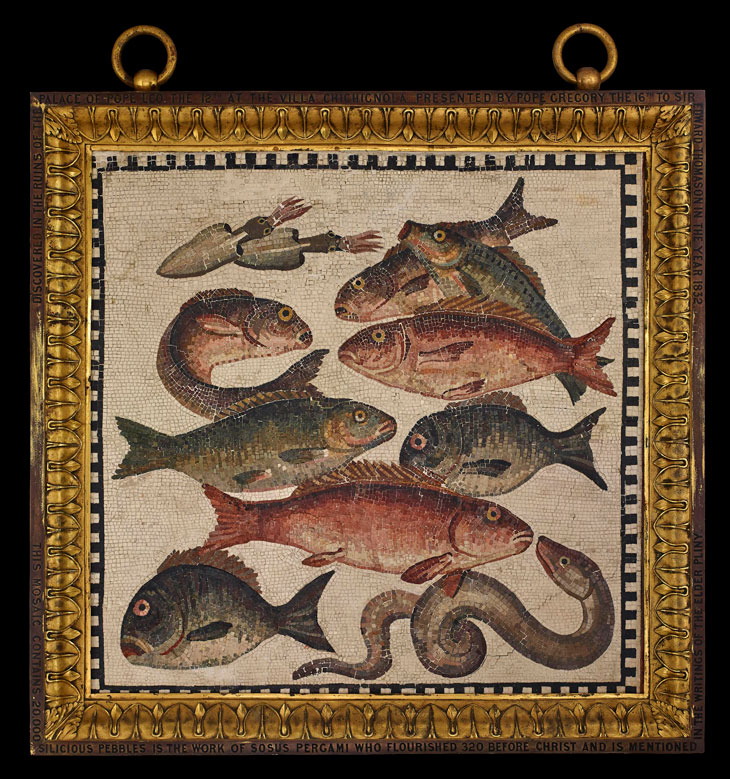
And if the apostles had instead fished in saltwater, some 1,500 years before Raphael came to depict them, what might they have caught? In 1832 Pope Gregory XVI gave the Birmingham manufacturer Sir Edward Thomason a panel from the mosaic floor excavated from Pope Leo XII’s Palace at the Villa Chichignola. Two years later this was given by Richard Norris to the Jesuit College at Stonyhurst, Lancashire. Published as a fake in 1980, before it was acquired by the British Museum, the mosaic is similar in style to another of a cat and two ducks in the Palazzo Massimo in Rome and is now accepted as authentic. Dated to between 50 BC and 50 AD, this provides visual evidence for seafish available during Christ’s lifetime. The fish include an eel (lower right), grey mullet (middle left), possibly mackerel (centre right), and red snapper (lower centre), and the mosaic also depicts squid (above left). Perhaps other classical representations did inspire the Miraculous Draught; there will be many more conversations with the fishmonger, no doubt.
The refurbished Raphael Court at the Victoria and Albert Museum, London, will reopen later this year.
